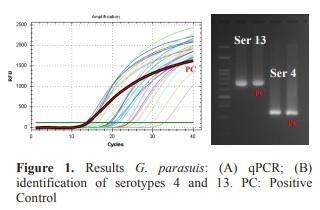Molecular characterization by serotyping PCR and LS-PCR of Glaesserella (Haemophilus) parasuis strains isolated from clinical cases in Peru
Published: July 15, 2022
By: Ana F. Castillo 1; Ines G. Alejos 2; Andre F. Sedano 2; Arturo A. Garcia 2; Juan F. Tomas 2; Karolina S.M. De La Cruz 2; Gerardo R. Diaz 3 / 1 Department of Veterinary Diagnostic and Production Animal Medicine, Iowa State University, Ames, IA, USA; 2 Private Practice, Lima, LIM, PE; 3 Department of Veterinary Population Medicine, University of Minnesota, Saint Paul, MN, USA.
Introduction
Molecular serotyping and LS-PCR are valuable and practical tools for Glaeserella parasuis characterization (1, 2). Early in 2020, and due to the forced postpandemic closure, several swine production systems in Peru reported clinical cases of G. parasuis, and a total of sixty-eight qPCR-positive microbiological isolates of clinical cases were obtained over two years. The objective of this study was to identify the circulating serotypes, and evaluate the presence of predictor vtaA virulent genes of the G. parasuis isolates from clinical cases in Peru. This study represents the first molecular diagnostic and serotyping report of virulent G. parasuis in Peru.
Materials and Methods
Pericardium, thoracic and synovial fluid, pleura, fibrin, lymph nodes, and lung specimens were collected at necropsy from suspicious animals of G. parasuisassociated disease from commercial swine farms in Peru. Primary G. parasuis isolation was performed on sterile blood agar plates with a Staphylococcus aureus nurse streak, and incubated at 37 °C for 48 hours. Subsequently, suspected G. parasuis colonies were purified by subculture on sterile trypticase soy + NAD agar plates at 37°C for 24-48 hours. The identification of purified isolates was performed using biochemical tests followed by subsequent molecular characterization. Bacterial DNA extraction was carried out using a Real PCR RNA/DNA Magnetic Bead Kit (IDEXX Laboratories, USA). Molecular diagnostic confirmation was made by amplification of infB gene by qPCR (3). For molecular serotyping, a multiplex PCR (mPCR) based on the variation within the capsule loci of the 15 serovars of G. parasuis was used (1). Additionally, a LS-PCR based on the leader sequences of the vtaA genes was performed to evaluate virulence (2). Both the molecular serotyping and LS-PCR were read in an electrophoresis gel agar.
Results
Sixty-eight isolates G. parasuis qPCR positives were obtained (Figure 1A), the most common was serotype 7 (n=55), following by serotype 1 (n=3), serotype 4 (n=2), serotype 13 (n=1), serotype 5-12 (n=1) and six isolates were nontypeable (Figure 1B). All isolates had the vtaA gene virulent predictor of G. parasuis.
Discussion and Conclusion
The clinical cases associated with serotype 7 of G. parasuis denote attention since it was previously considered non-virulent (4). The present work reports the first molecular detection and identification of serotypes 1, 4, 7, 5-12, 13, all virulent and associated with clinical cases in Peru, and highlights the detection of more than 55 virulent isolates positive for serotype 7. There is no cross-protection between G. parasuis do serotypes nor even isolates from the same serotype. Therefore, the identification of several G. parasuis virulent serotypes (serotypes 1, 4, 5-12, 13, and 7) circulating in Peru should generate special attention and reinforce the importance of timely and accurate diagnosis and subsequent implementation of specific control measures.

Acknowledgments
Dr. Luis Gimenez-Lirola for his great support and kind recommendations.
Presented at the 26th International Pig Veterinary Society Congress. For information on the event, click here.
References
1. Howell et al. 2015. J Clin Microbiol 53: 3812-3821.
2. Galofré-Mila. 2017. BMC Vet Res 13:124.
3. Turni et al. 2009. J Appl Microbiol 108: 1323-1331
4. Cerutti et al. 2020. Frontiers in Vet Sci 7: 98
Content from the event:
Related topics:
Authors:
Universidad Nacional Mayor de San Marcos (Perú)
Recommend
Comment
Share

Would you like to discuss another topic? Create a new post to engage with experts in the community.






